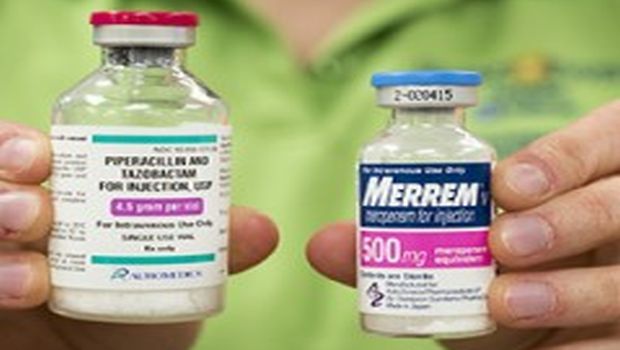Combination of Three Antibiotics Can Kill Staph Infections
Three antibiotics that, individually, are not effective against a drug-resistant staph infection can kill the deadly pathogen when combined as a trio, according to new research. The researchers, at Washington University School of Medicine in St. Louis, have killed the bug - methicillin-resistant Staphylococcus aureus (MRSA) - in test tubes and laboratory mice, and believe the same three-drug strategy may work in people.


Using three antibiotic drugs thought to be useless against MRSA infection - piperacillin and tazobactam (bottle at left) and meropenem - Washington University researchers, led by Gautam Dantas, PhD, have killed the deadly staph infection in culture and in laboratory mice. Photo courtesy of Robert Boston
Three antibiotics that, individually, are not effective against a drug-resistant staph infection can kill the deadly pathogen when combined as a trio, according to new research. The researchers, at Washington University School of Medicine in St. Louis, have killed the bug - methicillin-resistant Staphylococcus aureus (MRSA) - in test tubes and laboratory mice, and believe the same three-drug strategy may work in people.
“MRSA infections kill 11,000 people each year in the United States, and the pathogen is considered one of the world’s worst drug-resistant microbes,” says principal investigator Gautam Dantas, PhD, an associate professor of pathology and immunology. “Using the drug combination to treat people has the potential to begin quickly because all three antibiotics are approved by the FDA.”
The study is published online Sept. 14 in the journal Nature Chemical Biology.
The three drugs - meropenem, piperacillin and tazobactam - are from a class of antibiotics called beta-lactams that has not been effective against MRSA for decades.
Working with collaborators in the microbiology laboratory at Barnes-Jewish Hospital in St. Louis, Dantas’ team tested and genetically analyzed 73 different variants of the MRSA microbe to represent a range of hospital-acquired and community-acquired forms of the pathogen. The researchers treated the various MRSA bugs with the three-drug combination and found that the treatments worked in every case.
Then, in experiments conducted by collaborators at the University of Notre Dame, the team found that the drug combination cured MRSA-infected mice and was as effective against the pathogen as one of the strongest antibiotics on the market.
“Without treatment, these MRSA-infected mice tend to live less than a day, but the three-drug combination cured the mice,” Dantas says. “After the treatment, the mice were thriving.”
Dantas explained that the drugs, which attack the cell wall of bacteria, work in a synergistic manner, meaning they are more effective combined than each alone.
The researchers also found that the drugs didn’t produce resistance in MRSA bacteria - an important finding since more and more bacteria are developing resistance to available drugs.
“This three-drug combination appears to prevent MRSA from becoming resistant to it,” Dantas says. “We know all bacteria eventually develop resistance to antibiotics, but this trio buys us some time, potentially a significant amount of time.”
Dantas’ team also is investigating other antibiotics thought to be ineffective against various bacterial pathogens to see if they, too, may work if used in combination with other drugs.
“We started with MRSA because it’s such a difficult bug to treat,” he says. “But we are optimistic the same type of approach may work against other deadly pathogens, such as Pseudomonas and certain virulent forms of E. coli.”
Funding for this research comes from the National Institute of Diabetes and Digestive and Kidney Diseases and the National Institute of General Medical Sciences, and the National Institute of Allergy and Infectious Diseases of the National Institutes of Health (NIH). Additional funding comes from an NIH Director’s New Innovator Award and a Ruth Kirschstein National Research Service Award from NIH. Grant numbers are DP2 DK098089, R01 GM099538, AI90818, AI104987, GM007067, T32 GM075762, F31 AI115851.
Reference: Gonzales PR, Pesesky MW, Bouley R, Ballard A, Biddy BA, Suckow MA, Wolter WR, Schroeder VA, Burnham C-AD, Mobashery S, Chang M, Dantas G. Synergistic, collaterally sensitive ß-lactam combinations suppress resistance in MRSA. Nature Chemical Biology, published online Sept 14, 2015.
Source: Washington University in St. Louis
Show, Tell, Teach: Elevating EVS Training Through Cognitive Science and Performance Coaching
April 25th 2025Training EVS workers for hygiene excellence demands more than manuals—it requires active engagement, motor skills coaching, and teach-back techniques to reduce HAIs and improve patient outcomes.
The Rise of Disposable Products in Health Care Cleaning and Linens
April 25th 2025Health care-associated infections are driving a shift toward disposable microfiber cloths, mop pads, and curtains—offering infection prevention, regulatory compliance, and operational efficiency in one-time-use solutions.
Phage Therapy’s Future: Tackling Antimicrobial Resistance With Precision Viruses
April 24th 2025Bacteriophage therapy presents a promising alternative to antibiotics, especially as antimicrobial resistance continues to increase. Dr. Ran Nir-Paz discusses its potential, challenges, and future applications in this technology.